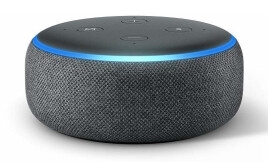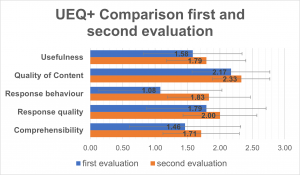Design and Development of an Alexa Skill “Nuk Alpha” to Improve Knowledge in the Field of Nuclear Medicine
Aim and Research Question(s)
The aim of this thesis was to design and develop a smart speaker skill to give interested people a clearer understanding of the field of nuclear medicine. The skill 'Nuk Alpha' was developed for the digital voice assistant software 'Amazon Alexa' and has been tested on the 3rd generation smart speaker Echo Dot. For the success of the skill following question was raised:
"How can the User experience change during two evaluation steps following a user-centred design process for a smart speaker skill, which provides information about nuclear medical procedures?"
 Figure 1: Echo Dot, 3rd Generation, powered by Alexa
Figure 1: Echo Dot, 3rd Generation, powered by Alexa
Background
Smart speakers like Amazon's Echo Dot or Google's Nest enjoy increasing popularity all over the world [1]. The great advantage of these devices lies in their simple way of operation, using only voice commands. Although these systems are easy to operate, they are not widely used in the medical field at the moment. Nuk Alpha is intended to be the first step in this direction.
Methods
To improve the user-experience and acceptance of future users, the development was done by following a User-Centred Design Process. The skill usability was tested by six different participants and their experience was later evaluated by a User-Experience Questionnaire+(UEQ+) [2] followed by a short interview. This was done in two iteration steps and the feedback was used to improve the prototype.
Results and Discussion
In Figure 2 it can be seen that the User Experience improved in all of the five categories evaluated in the UEQ+ during the development of the prototypes. The most distinct increase was achieved in the area of response behaviour, where the value rose from 1.08 (SD=1.19) to 1.83 (SD=0.8). This increase can be mainly attributed to the fact that the results of the first evaluation were used to improve the second prototype. The key factors there were the use of conversational markers and the shortened answers.
 Figure 2: Results UEQ+ - first and second evaluation
Figure 2: Results UEQ+ - first and second evaluation
Conclusion
Considering the feedback from the participants, an improved user experience was achieved in all five selected areas of the UEQ+. Since the number of participants was small and the scatter in the results very high, a larger test group should be taken into consideration for further tests in order to underline the results.
References
[1] G. McLean and K. Osei-Frimpong, ‘Hey Alexa … examine the variables influencing the use of artificial intelligent in-home voice assistants’, Computers in Human Behavior, vol. 99, pp. 28–37, 2019, doi: https://doi.org/10.1016/j.chb.2019.05.009. [2] Klein et. al., ‘Measuring User Experience Quality of Voice Assistants’, in 2020 15th Iberian Conference on Information Systems and Technologies (CISTI), 2020, pp. 1–4, doi: 10.23919/CISTI49556.2020.9140966
